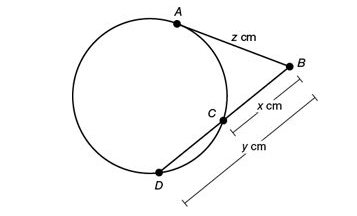dave13 wrote:
carcass wrote:

In the figure above, AB, which has length z cm, is tangent to the circle at point A, and BD, which has length y cm, intersects the circle at point C. If BC = x cm and \(z = \sqrt{xy}\), what is the value of x ?
(1) CD = x cm
(2) \(z = 5 \sqrt{2}\)
amanvermagmat wrote:
prashant0099 wrote:
carcass , Can you please let us know . How this question can be solved.
Thanks.
Hi
You can go through the solutions posted in this thread.
You can also read about circles theory here:
https://gmatclub.com/forum/math-circles-87957.htmlhey
generis today is international day of indepencence

so i tried to solve the above DS question independently,

i ve read whole thread also visited this link...
but i smply couldnt understand how to approach the problem...
i know formula of area of circle PiR^2 and also circumference 2PiR
i know what is tangent, what is diametr and radius, but still couldnt wrap my mind aroud this problem what rule to apply here , can you help please

have a fantastic day

, cosmopolitanism meets metaphor meets smiley face ... Classic.

This question is not about area or circumference.
It involves the "power of a point" theorem, one version of which is called the "secant-tangent theorem."
I'll put
reference material below.BUT: you do not need to use the secant-tangent theorem.
I will use the theorem in Method II because a harder question would not give us \(z=\sqrt{xy}\)
The power of a point theorem has three iterations, is very useful, and is not hard.
Initially it might appear so. Read material linked below.

We do not need the theorem because this part is given: \(z=\sqrt{xy}\)
The variables are lengths, thus positive. Square both sides: \(z^2=xy\)
See below. That equation is the essence of the secant-tangent theorem.
I. WITHOUT the theorem - Unique value for \(x\)?
(1) \(CD = x\) cm
\(y - CD = x\)
\(y - x = x\)
\(y=2x\)
Given: \(z=\sqrt{xy}\)
\(z=\sqrt{x*2x}=\sqrt{2x^2}=x\sqrt{2}\)
\(z=x\sqrt{2}\)
Two variables, one equation. Insufficient.
OR: we know nothing about \(z\), hence nothing about \(x\)
Or: test numbers that make this statement true: \(z=x\sqrt{2}\)
If you can get two different values for \(x\), #1 is insufficient
Let \(x = 25\) and \(z = 25\sqrt{2}\)
Let \(x = 2\) and \(z = 2\sqrt{2}\)
Two values of x = not unique
INSUFFICIENT alone. Cross off A and D
(2) \(z = 5\sqrt{2}\)
\(z=\sqrt{xy}\)
\(z = 5\sqrt{2}\)
\(5\sqrt{2}=\sqrt{xy}\)
Two variables, one equation. Insufficient.
OR: we know nothing about \(y\), hence nothing about \(x\)
OR test numbers.
\(z=\sqrt{xy}\)
\((5\sqrt{2})=\sqrt{xy}\)
Let \(x = 5\) and \(y = 10\)
Let \(x = 10\) and \(y = 5\)
#2 does not yield a unique solution for \(x\). Insufficient. Cross off B.
C or E?
Combine #1 and #2:
#1, expanded:
\(y = 2x\)
\(z=\sqrt{xy}\)
\(z=\sqrt{x*2x}=\sqrt{2x^2}\)
Combined #1 and #2
\(5\sqrt{2}=\sqrt{2x^2}\)
One variable, one equation. Sufficient. Or solve
\(5\sqrt{2}=x\sqrt{2}\)
\(x=5\) That works
Answer C
II. Secant-tangent theoremIn the diagram, point B lies outside the circle.
AB (= z) is tangent to the circle
BD is a secant, a line that intersects a circle at two points
BD (= y) has two segments, BC (= x) and CD
The secant-tangent theorem states
\((AB)(AB)=(BC)(BD)\)
\((AB)^2=(BC)(BD)\)In this case, using the theorem with given lengths, we have
\(z^2=xy\)
We need information about \(y\) and \(z\) to get a unique value for \(x\)
(1) \(CD = x\)
Inspect the diagram: \(y=2x\), or
\(y - CD = x\)
\(y - x = x\)
\(y=2x\)
From secant-tangent theorem:
\(z^2=xy\)
\(z^2=(x*2x)=2x^2\)
Two variables, one equation.
Insufficient.
Test numbers:
Let \(x = 1\) and \(z = \sqrt{2}\)
Let \(x = 2\) and \(z = \sqrt{8}\)
Or, we know nothing about value of \(z\), so we still know nothing about \(x\).
#1 alone is insufficient. Cross off A and D
(2) \(z = 5 \sqrt{2}\)
From the secant-tangent theorem, we know \(z^2=xy\)
\((5\sqrt{2})^2=xy\)
\(50=xy\)
Two variables, one equation. Insufficient.
OR, we know nothing about \(y\) and hence nothing about \(x\)
OR test numbers.
\(50=xy\)
Values: \(x=2\) and \(y=25\)
\(x=10\) and \(y=5\)
\(x\) does not have one unique value - insufficient
(2) alone is insufficient. Cross off B.
(C) or (E)?
Combine #1 and #2
\(z^2=2x^2\) and \(z=5\sqrt{2}\), so
\((5\sqrt{2})^2=2x^2\)
One variable, one equation: sufficient
If you need to, do the math:
\((5\sqrt{2})^2=2x^2\)
\(50=2x^2\) --> \(x=\sqrt{25}\) --> \(x=5\) (length cannot be (-5)
Answer C
Hope that helps.
 Good reference material:
Good reference material:
A simple overview and ways to remember each power theorem is HERE
Secant-tangent with a simple proof is HERE.
Rules for Chords, Secants, and Tangents in a Circle are HERE.
Power of a Point Description and Problems are HERE
Power of a Point Theorem - material is short and dense
Then see the the page linked above, at the Power of a Point section.P.S.
mikedays , I answered your query via PM.




 15%
(low)
15%
(low)
 19%
(02:16)
wrong
19%
(02:16)
wrong  based on 1920
sessions
based on 1920
sessions



